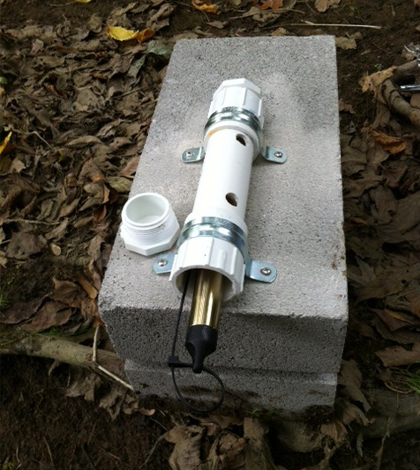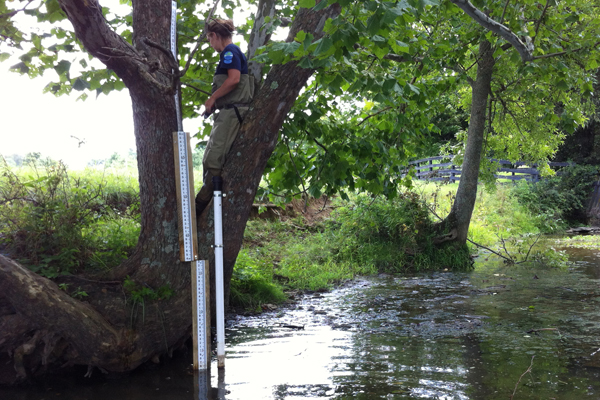Kentucky DEP measures Strodes Creek discharge to inform future TMDLs

A Solinst Barologger Edge Barometric Pressure Logger is mounted on a cinder block. (Credit: Jessica Schuster)
In 2005, 44 segments of Kentucky’s Strodes Creek were found to not meet designated use requirements under the Clean Water Act, according to the Kentucky Division of Water. Eleven of those were found to not meet recreational usage standards, meaning E. Coli concentrations in those areas was too high for swimming.
The Kentucky Department of Environmental Protection has since stepped up to improve best management practices in the creek’s watershed and make its water quality better. One of the agency’s ongoing projects is focused on the establishment of Total Maximum Daily Loads so that pollutants getting into the creek can be mitigated.
An important measurement for establishing those targets is stream discharge, which is linked to pressure. Scientists at the DEP are tracking that through a series of stream monitoring stations. One station relies on a Solinst Barologger Edge Barometric Pressure Logger that is used in conjunction with pressure transducers.
“The transducers provide measurements of the absolute pressure (water pressure plus atmospheric pressure) every 15 minutes,” said Jessica Schuster, environmental biologist at the Kentucky DEP. She works with Katie McKone, also an environmental biologist with the DEP, to collect the stream data. “In order to back-calculate the true water pressure, we’re measuring atmospheric pressure using the barometric loggers. Once we have the water pressure, we can determine water level in order to create a discharge rating curve and a continuous record of discharge.”

Transducers are deployed in PVC pipes along Strodes Creek. (Credit: Jessica Schuster)
The effort coincides with other sampling work in Strodes Creek that is charting parameters related to its water quality. These include levels of dissolved oxygen, specific conductivity and nutrients.
Schuster and McKone are giving those measurements greater significance by relating them to water levels. And the relationship between levels and water quality is helping to pinpoint the critical conditions of Strodes Creek that are important for developing accurate Total Maximum Daily Load requirements.
So far the work has been an exercise in making sure no bases are left uncovered as biologists work to put together an accurate picture of the health of Strodes Creek. Measurements from the barologgers and transducers are some of the most important for doing that, says Schuster.
“Having a continuous stream discharge record, in conjunction with water chemistry data, will allow us to better define the critical conditions within Strodes Creek,” said Schuster.
Though there’s still work to be done, Schuster has some results to report. A site that is mostly urban influenced has the flashiest hydrograph in the data set, while a larger site has a less extreme and prolonged hydrograph.
“While not surprising, seeing the data graphed has been exciting and has shown us just how high some of the stage heights can get, and how quickly,” she said.
Top image: A Solinst Barologger Edge Barometric Pressure Logger is mounted on a cinder block. (Credit: Jessica Schuster)




0 comments